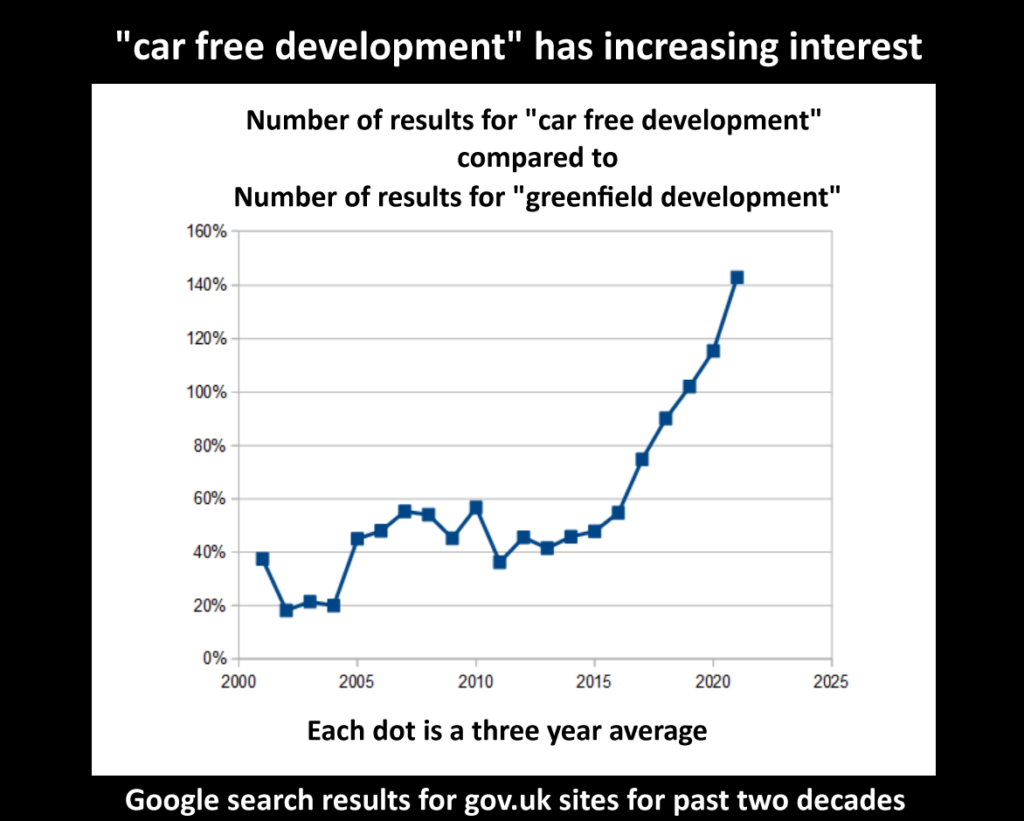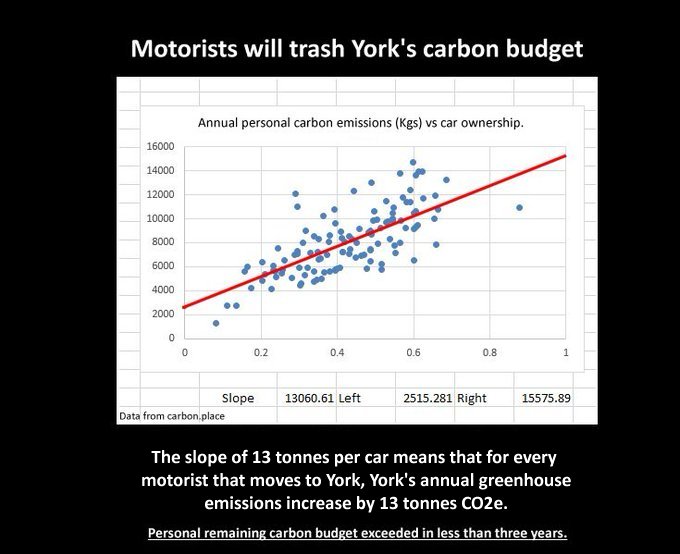Car free development lessens inequality
The Government have asked for views on their approach to updating to the National Planning Policy Framework.
This is Part 2 of my submission.
Car free development
Planners now realise there is a section of society that can’t afford cars. Some London Boroughs have housing developments for “affordable” housing where residents give up the right to keep a car.
Also, new planning ideas aim to improve city life in “15 minute cities” where there are fewer cars. This is being applied in Paris by the Mayor, Anne Hidalgo. The term “15 minute city” was coined by Professor Carlos Moreno in 2016. He argued that the daily urban necessities should be a 15-minute reach on foot or bike, including work, hope, shops, education and healthcare. More like British streets before mass ownership of cars moved these facilities to out of town centres …

The interest in car free development has increased over the past two decades. To test this I compared the number of results in Google searches for the term “car free development” with those for “greenfield development”. The graph based on Google searches of “gov.uk” sites shows the increasing interest in car free development in the past two decades.

Here I discuss the consequences of making all new major housing developments car-free. Such a policy would address two current issues: inequality in housing and climate change. The inequality is between the young and the old and between the affluent and the poor. The proposal also addresses the inadequacy of town planning in dealing with the climate crisis.
For simplicity, I model the housing market as three parts: property owners, renters and developers. The term “developer” includes “land owner”. The two are not the same but in practice can be difficult to separate.
Planning Gain and Property Location Rights
In its simplest form, planning gain is the increase in value of a plot of land, when planning permission to build a house is granted. Planning permission creates a Property Location Right, the right to have a building on that plot. Elsewhere, using data from Office of National Statistics, I have estimated that Property Location Rights constitute half the wealth of the UK. (I made this estimate by subtracting agricultural land values from the land values that the ONS has calculated.)
Granting planning permission creates a new Property Location Right, which becomes part of the value of the new house. In York, the value of this Property Location Right is between £150,000 and £200,000 for an individual house. This can be more than half the value of a new house. The value of this Property Location Right accrues to the developer.
If monopolies on land ownership could be tackled, granting enough permissions could reduce the price of housing, both new and old, by increasing the supply of Property Location Rights so the extra supply lowers their value.
However, the Bank of England has expressed concern about cheap housing affecting financial stability:
If additional housing supply was to cause sharp declines in house prices, this might raise concerns about the adequacy of mortgage lenders‘ capital positions and hence raise financial stability concerns.
Letter from Andy Haldane, Chief Economist, Bank of England, May 2014
Restricting the supply of planning permission, maintains the value of Property Location Rights – and helps financial stability. Restrictions benefit existing property owners, as property prices rise – at the expense of those who rent. Developers also benefit from a tighter housing market and are sometimes accused of deliberately slowing housing supply by holding back developments they already have permission to build.
Financial stability is achieved at the expense of those who rent: the young and the poor.
The Department of Levelling Up did initially take the affordability of housing seriously. It encouraged local authorities to plan for more house building to bring prices down. Their White Paper says “The current planning system enables some developers to benefit disproportionately and unfairly from the land they develop.” Politics may have overcome these intentions.
The “disproportionate benefit” is driven by the shortage of building land. This shortage is not a shortage of land per se: Only 8.7% of the land in the UK is developed. The shortage is for land with planning permission that is available for housing – and not being hoarded by developers.
As there is plenty of undeveloped land around most towns in the UK, the shortage boils down to a shortage of Property Location Rights which are not being hoarded by developers.
Segmenting the housing market
Where housing supply is limited, the market pushes up prices for those buying and those that rent. High demand from those that can afford to buy will cause a rise in house prices – but not because houses are more expensive to build. A rise in demand increases the value of rights to locate properties i.e. the value of Property Location Rights.
Because high house prices often mean that local residents cannot afford to stay in the villages or towns they were born into, the Government has introduced policies for providing social housing for local people at lower prices. The Government asks that planning authorities “ensure that, as far as possible, sufficient affordable housing is available for those amongst the local population who are on low incomes”. This segments the housing market into “affordable” and “market value” housing.
The proposal in this article segments the housing market differently – into existing property with legacy rights of car ownership and new housing development which is car free. This will have will have a similar – but broader – effect to the division into “affordable” and “market value” homes.
New housing excluding cars can provide much cheaper houses for those willing to live car free because when they buy or rent a home they will not be burdened by the extra premium of inflated value of Property Location Rights. They can also have the local facilities that have been closing down as cars have moved into areas: local shops, pubs, bus services & etc.
Climate change and car ownership
This proposal does more than correct inequality in the housing market. A much bigger issue is climate change. The effects of increased carbon emissions due to extra motorists can be seen in data underlying the website carbon.place:

Also the House of Commons Science and Technology Committee has noted:
In the long-term, widespread personal vehicle ownership does not appear to be compatible with significant decarbonisation.
Reaching net zero emissions, cannot be achieved without significant decarbonisation – and it must be done quickly to keep within remaining carbon budgets. That means becoming car free soon.
Relevant tweets on Twitter
TrackBack URL :
